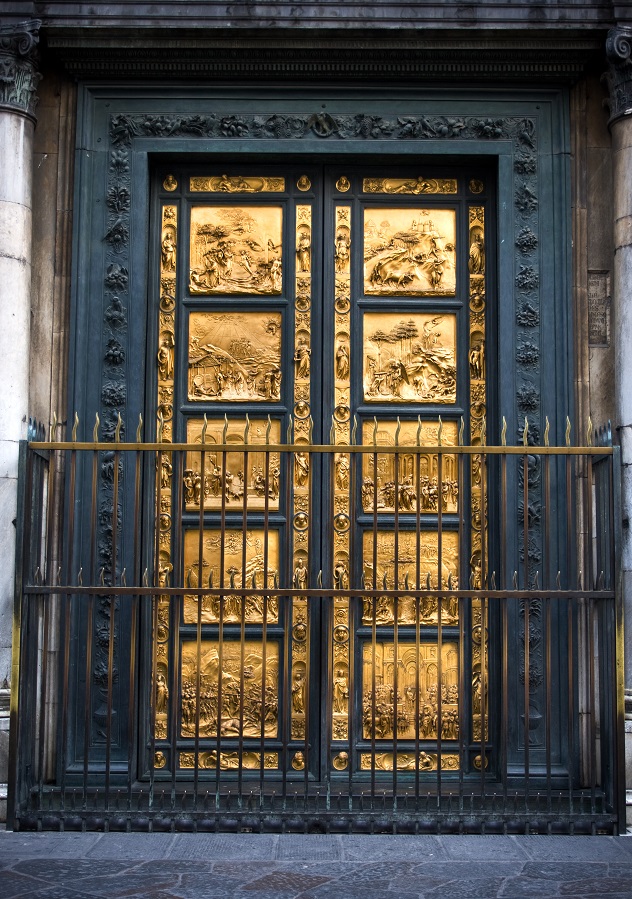Visitors to the Nelson-Atkins Museum of Art will be greeted by a copy of Ghiberti’s baptistery doors
by VICTORIA STAPLEY-BROWN | 19 July 2017
The Art Newspaper
If not for unexpected morning rain, Kansas City would not be celebrating a major gift: a bronze cast of Lorenzo Ghiberti’s 15th-century Gates of Paradise. The original gilded doors were made for the east entrance of the baptistery in front of Florence Cathedral by Ghiberti and his workshop from 1425 to 1452. They depict scenes from the Old Testament and their startling virtuoso relief—figures are placed in landscapes or perspectivally rendered architecture to suggest depth—influenced generations of artists. When Michelangelo saw them, he said: “They are truly worthy to be the Gates of Paradise.”
Now the Nelson-Atkins Museum of Art in Kansas City, Missouri, is installing a bronze copy of the famous doors in its entrance hall. The museum’s director, Julián Zugazagoitia, describes the original doors as the starting point (“art history 101”) for understanding the Renaissance, and says his museum obtained its copy of them through “luck and serendipity”.
Unexpected discovery
In 2015, when the Nelson-Atkins trustee Paul DeBruce and his wife, Linda Woodsmall-DeBruce, were visiting Florence, rain interrupted their plans to hike in the hills around the city. They went instead to the Frilli Gallery Sculpture Art Studio and met the development director, Clara Marinelli, who suggested they visit the Marinelli Foundry for the Frilli Gallery.
The DeBruces discovered that when a copy of the gates was cast at the foundry in 1990 to replace the original doors on the baptistery (which were moved for safekeeping to the Opera del Duomo museum), another bronze version was made for the Japanese collector Chochiro Motoyama, an importer of Italian luxury goods, who funded the restoration of the original doors and the casting of a replacement. The second copy of the doors, which belonged to Motoyama, had been left in storage ever since, apart from appearing in an exhibition in India and South Korea (2013-16).
The DeBruces bought the copy from the Japanese collector. They transported the gates to New York by ship, then on to Kansas City by train and truck. The 17ft-high doors, which weigh four-and-a-half tonnes, have been hung on the walls of the lobby of the museum’s Bloch Building and will be revealed to the public later this year. (To support their weight, they have been anchored into the metal of an elevator shaft.)
People respond to the doors “because of their narrative quality”, Zugazagoitia says. The scenes depicted, including the Creation of Adam and Eve, fill ten square panels. To create the illusion of depth and movement, “the relief is shallow at the bottom and deeper at the top”, the museum’s senior curator of European arts, Aimee Marcereau DeGalan, explains in a statement. Decorative foliage and fruit, as well as statuettes and busts— including the artist’s self-portrait and a portrait of his father, Bartolomeo— surround the squares.
The addition of the Gates of Paradise offers a “new way of framing” the museum’s Old Masters collection, Zugazagoitia says. It also gives insight into the development of Western art and creates a “nice dialogue and tension” with a contemporary work in the lobby, a tapestry made from recycled bottle tops by the Ghanaian artist El Anatsui. “What better way to enter the museum than [by seeing] a great piece of art?” Zugazagoitia asks.
Image: Casts of the original Gates of Paradise are now installed on the outside of the Baptistery in Florence. Photo provided by iStock.
